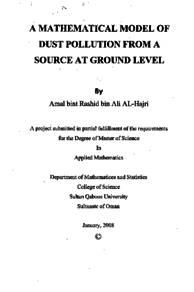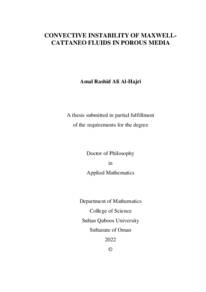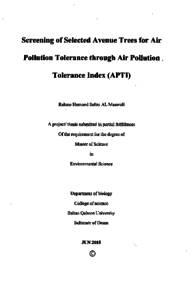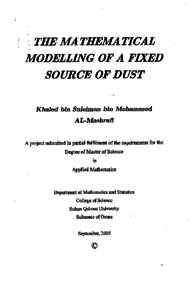Document
A mathematical model of dust pollution from a source at ground level
Publisher
Sultan Qaboos University
Gregorian
2008
Language
English
Subject
English abstract
The distribution of dust particles emitted by a source at ground level is studied in the presence of wind, gravitational settling and vertical diffusion. We consider Cartesian frame of reference in which the x-axis is horizontal and in the direction of the wind while the z-axis is vertically upwards. The equation governing the model is derived and the model is formulated as a boundary value problem in the (x,z) plane. The boundary value problem involved the parameters: w which measures the influence of gravity, the roughness height Zo, the source strength parameter, Co,and two parameters B,m defining the wind profile. The parameters of the problem are reduced to two using a special transformation.
The boundary-value problem is solved by the method of integral transforms. The inversion of the transformed solution was, in general, not possible for all source functions. In the case of small roughness heights (i.e. when z, «l), the inversion can be simplified for any source function. This case provided the means for examining the influence of the source and wind profiles on the concentration of dust. The case zo =0(1), in units of meter, is solved for a special form of the source function. In both cases, the inversion was not obtainable from the standard transformn tables and is achieved by the method of contour integration. This required the construction of suitable contours that took into account poles and branch points of the integrand. The final solution is obtained in a closed form in the form of an integral of a real integrand.
The solutions are evaluated numerically and the results are presented graphically. The isolines of the dust concentration in the (x,z) plane are presented for various values of the governing parameters. Individually gravity is to suppress the rise of the dust and the wind tends to blow the dust horizontally but when both factors act simultaneously in the presence of vertical diffusion and a ground level source the distribution of dust becomes a complicated function of these factors. If the source is uniform and covers a finite distance, the resulting diffusion shows a maximum height at the end knee of the source function indicating that the sharp decrease in the source (steep gradient) helps the diffusive eddies to offset the action of gravity. When the source has smooth maximum values, the dust distribution shows a good correlation between the height and the source local value. The influence of the roughness height is found to lead to an enhancement of dust concentration with the increase in zo
Description
Thesis
Member of
Resource URL
Arabic abstract
تمت دراسة انتشار الغبار تحت أثر الرياح وقوة الجاذبية الأرضية. لقد وصفنا الإحداثيات كالأتي: المحور السيني ( x - axis ) أفقيا في إتجاه الرياح والمحور الصادي ( axis- =) عموديا. لقد تم استنباط المعادلات التي تحكم النموذج الذي صمم كمسأله قيم طرفيه على المستوى سرع). هذه المسألة تحتوي على معالم يمكن التحكم فيها وهي مقياس تأثير الجاذبيه الأرضية و مقياس إرتفاع طبقة الخشونة, كما أن هنالك مقياس قوة المصدر. ..
لقد تم تحويلها بطريقة التحويلات ولكن طريقة التكامل لكل دوال المصدر غير ممكنه إلا في حالة أن سمك طبقة الخشونة تؤول إلى الصفر(2 0), يمكن تبسيطها لأي دالة مصدر. هذه الحاله تمنحنا اختبار قوة المصدر و كثافة الغبار في الرياح. تم حل الحاله (1) 0= 2 لدالة مصدر خاص. في كلا الحالتين النتائج لم توجد من جداول التحويل وقد وجدت بطريقة التكامل الكنتوري, يتطلب هذا وضع کنتور مناسب يأخذ في الإعتبار الأقطاب والنقاط الفرعية للدالة المطلوب تكاملها. تم وضع الحل النهائي على صورة تكامل لدالة حقيقية .
تم تقييم الحلول وعرضه على شكل رسوم بيانيه, تم عرض خطوط تكافؤ كثافة الغبار في المستوى (سرع) لعدة قيم للمعالم التي تحكم المسأله. إذا أخذنا أثر قوة الجاذبية والرياح كل على حده, فإن الجاذبية تقلل من إرتفاع الغبار وتنشره الرياح أفقيا ولكن اذا أخذناهم معا في وجود انتشار رأسي والمصدر على مستوى سطح الأرض, فإن توزيع الغبار يصبح دالة معقده تعتمد
على هذه العوامل مجتمعه. إذا كان المصدر منتظم ويغطي مساحه مخدده فإن الإنتشار الناتج يبلغ اقصى ارتفاع عند الطرفية لدالية المصدر مما يعني أن أي انخفاض حاد للمصدر يساعد دوامات. الإنتشار في التغلب على الجاذبية الأرضية. عندما تكون القيم العظمى للمصدر ناعمة, فإن توزيع الغبار يشير إلى وجود ارتباط وثيق بين الأرتفاع ومحلية المصدر، وجدنا أن تأثبر الخشونة يؤدي إلى زيادة تركيز الغبار
لقد تم تحويلها بطريقة التحويلات ولكن طريقة التكامل لكل دوال المصدر غير ممكنه إلا في حالة أن سمك طبقة الخشونة تؤول إلى الصفر(2 0), يمكن تبسيطها لأي دالة مصدر. هذه الحاله تمنحنا اختبار قوة المصدر و كثافة الغبار في الرياح. تم حل الحاله (1) 0= 2 لدالة مصدر خاص. في كلا الحالتين النتائج لم توجد من جداول التحويل وقد وجدت بطريقة التكامل الكنتوري, يتطلب هذا وضع کنتور مناسب يأخذ في الإعتبار الأقطاب والنقاط الفرعية للدالة المطلوب تكاملها. تم وضع الحل النهائي على صورة تكامل لدالة حقيقية .
تم تقييم الحلول وعرضه على شكل رسوم بيانيه, تم عرض خطوط تكافؤ كثافة الغبار في المستوى (سرع) لعدة قيم للمعالم التي تحكم المسأله. إذا أخذنا أثر قوة الجاذبية والرياح كل على حده, فإن الجاذبية تقلل من إرتفاع الغبار وتنشره الرياح أفقيا ولكن اذا أخذناهم معا في وجود انتشار رأسي والمصدر على مستوى سطح الأرض, فإن توزيع الغبار يصبح دالة معقده تعتمد
على هذه العوامل مجتمعه. إذا كان المصدر منتظم ويغطي مساحه مخدده فإن الإنتشار الناتج يبلغ اقصى ارتفاع عند الطرفية لدالية المصدر مما يعني أن أي انخفاض حاد للمصدر يساعد دوامات. الإنتشار في التغلب على الجاذبية الأرضية. عندما تكون القيم العظمى للمصدر ناعمة, فإن توزيع الغبار يشير إلى وجود ارتباط وثيق بين الأرتفاع ومحلية المصدر، وجدنا أن تأثبر الخشونة يؤدي إلى زيادة تركيز الغبار
Category
Theses and Dissertations




